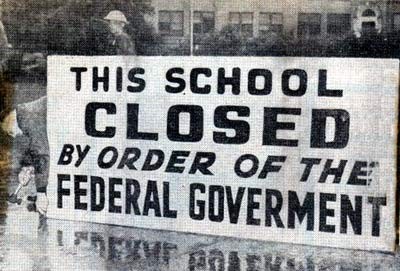The following peer-reviewed articles examine the privatization movement – its history, its ideology, its consequences, and how it can be challenged. A synthesis of the two articles is provided below.
Ellison, S. (2012). From Within the Belly of the Beast: Rethinking the Concept of the ‘Educational Marketplace’ in the Popular Discourse of Education Reform Journal of the American Educational Studies Association, 48(2), 119-136.41
Cortez, G. A. (2013). Occupy Public Education: A Community’s Struggle for Educational Resources in the Era of Privatization. Equity and Excellence in Education, 46(1), 7-19.40
Explaining the privatization movement, Ellison writes about the rise of the “educational marketplace” through the concept of globalization. A Nation at Risk, a report published in 1983 evaluating the state of the U.S. education system, depicted public schools as failing institutions.41 The report portrayed the failure of public schools as the reason for the U.S. falling behind in educational and economic competition with other countries.41 In response, accountability measures were created in order to ensure that the U.S. education system was producing “qualified workers for the emerging global political economy.”40 Corporate interest groups advocated for and successfully implemented standardized testing in schools, pressuring the federal government to pass the No Child Left Behind mandate in 2002.40 With the passing of NCLB, public schools that perform poorly on standardized tests receive less funding and are even closed.40
 28
28
Rather than improving community schools, education policy currently favors the privatization of public schools. Schools have come to be seen as commodities, with parental choice and competition serving to keep schools accountable for producing academic results.41 In the ideal, competition would produce a diversity of specialized schools and provide an incentive for schools to innovate and improve. Ellison explains that market-based reforms are based on this very assumption that consumer demand and competition will increase academic achievement, especially in areas that are currently underserved by public schools.41 However, research literature on school choice reveals that schools of choice are not particularly more effective than public schools, and rather stratify students based on class, race, and ethnicity.41
Despite the fact that competition does not appear to increase student achievement but rather has social costs, market-based reforms continue to dominate policy-debates on education. Claiming that market-based reformers hide behind a façade of accountability, Ellison describes the educational marketplace as a corporate play of power.41 Corroborating this claim, Cortez relates that public school funding in Chicago has been mishandled. He reports that Tax-Increment Financing (TIFs), money given to the city council for public services such as public schools, is being used to support private economic development projects.40 In order to transform Chicago into a leading global metropolis, public education and the communities they serve have been denied equitable funding.40
Nevertheless, current public school policies and the corporate interests that they represent can be contested and potentially changed through grassroots activism, as it allows community interests to be heard. Cortez gives an example of a group of mothers in Chicago who contested Chicago Public Schools (CPS) decision to demolish a field house belonging to Whittier Elementary School. The field house served as an education center, but CPS wanted to convert it into a playing field for a private high school.40 The mothers, along with their children and other community members, occupied the field house for a total of 43 days in opposition to this decision.40 By the end of Cortez’s research in 2010, the CPS CEO announced that the field house would not be destroyed.40 However, the Whittier Parent Committee website shows that the field house has since been demolished, and as of August 2013, parents were demanding the construction of a new field house. Though grassroots activism includes a series of losses and gains, it provides a space for communities to challenge existing public school policies.
 31
31
